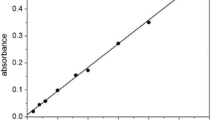Abstract
Potentiostatic control of a rotating cylinder electrode reactor enabled copper retrieval from a solution containing multiple metallic ions. The treated solution (pH 4 sulphuric acid) was obtained from a mine tailing. A batch process was used in laboratory experiments to simulate possible industrial treatments. Oxygen reduction was the major parasitic reaction at the cylinder cathode since the reactor was not separated, allowing the gas produced at the anode to dissolve in the electrolyte. A higher current therefore generated an increase in oxygen production and an increase in dissolved oxygen concentration. Since the oxygen reduction proceeded under diffusion control, the oxygen reduction current efficiency also increased. Reduction of ferric ions to a ferrous state and arsenic deposition were other less important side reactions decreasing current efficiency. Polarization experiments were conducted using a rotating disk electrode to study the reactions encountered at the cylinder cathode.
Similar content being viewed by others
Abbreviations
- a :
-
constant used in Equation 3
- A :
-
cathode active surface (cm2)
- c :
-
concentration (mol cm−3)
- d :
-
diameter (cm)
- D :
-
diffusion coefficient (cm2 s−1)
- F :
-
Faraday constant (96 490 C mol−1)
- H :
-
cylinder height (cm)
- I :
-
current (A)
- k :
-
mass transfer coefficient (cm s−1)
- n :
-
number of electrons exchanged in the global reaction
- Re :
-
Reynolds number (ωd2/2ν)
- Sc :
-
Schmidt number (ν/D)
- Sh :
-
Sherwood number (kd/D)
- t :
-
time (s)
- V :
-
solution volume (cm3)
- ν:
-
kinematic viscosity (cm2 s−1)
- ω:
-
angular speed (rad s−1)
- c:
-
cylinder
- Cu:
-
copper
- d:
-
disc
- Fe:
-
iron
- l:
-
limiting
- t:
-
at time t
- 0:
-
initial
References
D. G. Feasby, M. Blanchette, G. Tremblay and L. L. Sirois, in ‘Second International Conference on Abatement of Acidic Drainage’, vol. 1, Canada Center for Mineral and Energy Technology, Energy, Mines and Resources Canada, Ottawa (1991) p. 1.
F. Ramade, ‘Pŕecis d'Écotoxicologie’, Masson, Paris (1992).
F. M. D'Itri, in ‘Sediments: Chemistry and Toxicity of InPlace Pollutants’, Lewis Publishers, Boston (1990) p. 163.
C. Payette, W. W. Lam, C. W. Angle and R. J. Mikula, in ‘Second International Conference on Abatement of Acidic Drainage’, vol. 2, Canada Center for Mineral and Energy Technology, Energy, Mines and Resources Canada, Ottawa (1991) p. 15.
M. Bergeron, R. Boisvert, S. Chevé, J. Cyr, D. Germain, M. Piotte, N. Massé, K. Oravec and N. Tassé, ‘Restauration et Revalorisation de Pares de Résidus Miniers’, PMC-II project, report number 1, INRS-Géoressources, Ste-Foy, Québec (1992).
PMC-11 team, ‘Restauration et Revalorisation de Pares de Résidus Miniers’, PMC-II project, report number 2, INRS-Géoressources, Ste-Foy, Québec (1993).
INRS-Georessources, ‘Restauration et Revalorisation de Pares de Résidus Miniers’, PMC-II project, final report, INRS-Géoressources, Ste-Foy, Québec (1993).
J. St-Pierre, N. Massé, E. Fréchette and M. Bergeron, ‘Zinc Removal from Dilute Solutions using a Rotating Cylinder Electrode Reactor’, J. Appl. Electrochem., submitted.
‘CRC Handbook of Chemistry and Physics’, 65th edn, CRC Press, Boca Raton, Florida (1984).
P. Strickland and F. Lawson, Australas. Inst. Min. Metall. Proc. 237 (1971) 71.
G. Johansson, Talanta 12 (1965) 163.
L. E. Vaaler, J. Electrochem. Soc. 125 (1978) 204.
D. R. Gabe and F. C. Walsh, in ‘The Reinhardt Schuhmann International Symposium on Innovative Technology and Reactor Design in Extractive Metallurgy’ (edited by D. R. Gaskell, J. P. Hager, J. E. Hoffman and P. J. Mackey), The Metallurgical Society of AIME, Warrendale, PA (1986) p. 775.
F. C. Walsh and D. R. Gabe, Surf. Technol. 12 (1981) 25.
T. Takahashi, M. I. Ishmail and T. Z. Fahidy, Electrochim. Acta 26 (1981) 1727.
D. R. Gabe, J. Appl. Electrochem. 4 (1974) 91.
D. R. Gabe and F. C. Walsh, ibid. 13 (1983) 3.
N. A. Gardner and F. C. Walsh, in ‘Electrochemical Cell Design’ (edited by R. E. White), Plenum Press, New York (1984) p. 225.
F. C. Walsh, in ‘Electrochemistry for a Cleaner Environment’ (edited by J. D. Genders and N. L. Weinberg), Electrosynthesis Company Incorporated, East Amherst, New York (1992) p. 101.
Z. A. Foroulis and H. H. Uhlig, J. Electrochem. Soc. 111 (1964) 13.
I. Cornet and R. Kappesser, Trans. Inst. Chem. Eng. 47 (1969) T194.
J. St-Pierre, N. Massé and M. Bergeron, Electrochim. Acta 39 (1994) 2705.
J. St-Pierre, N. Massé and M. Bergeron, ‘Dissolved Oxygen Concentration in a Divided Rotating Cylinder Electrode Reactor’, Electrochim. Acta, accepted.
Author information
Authors and Affiliations
Rights and permissions
About this article
Cite this article
Massé, N., St-Pierre, J. & Bergeron, M. Copper removal from aerated solution containing various metal ions using an undivided rotating cylinder electrode reactor. J Appl Electrochem 25, 340–346 (1995). https://doi.org/10.1007/BF00249652
Received:
Revised:
Issue Date:
DOI: https://doi.org/10.1007/BF00249652




